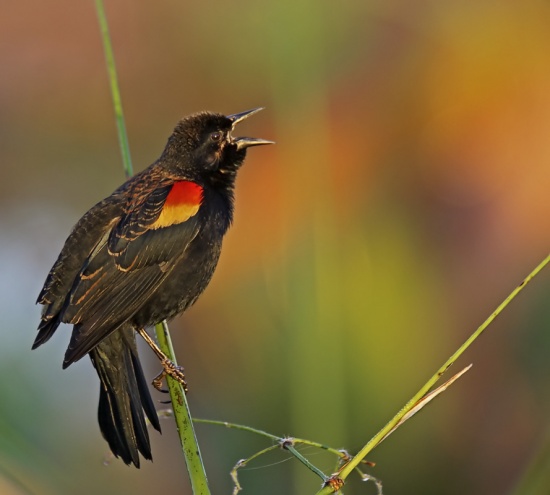(added range for similar species) |
Birder4eva (talk | contribs) |
||
| Line 21: | Line 21: | ||
==Behaviour== | ==Behaviour== | ||
| − | Can fly at speeds of up to 30 mph during migration. | + | Can fly at speeds of up to 30 mph during migration. Males sit with tails slightly flared. |
====Breeding==== | ====Breeding==== | ||
Although primarily a marsh bird, the Red-winged Blackbird will nest near virtually any body of water and occasionally breeds in upland pastures. Each pair raises two or three broods a season, building new nest for each clutch. Each time they build a new nest, which keeps the nest from becoming infected with parasites that could kill the baby birds. | Although primarily a marsh bird, the Red-winged Blackbird will nest near virtually any body of water and occasionally breeds in upland pastures. Each pair raises two or three broods a season, building new nest for each clutch. Each time they build a new nest, which keeps the nest from becoming infected with parasites that could kill the baby birds. | ||
Revision as of 17:10, 23 July 2014
- Agelaius phoeniceus
Identification
Male: A small blackbird with jet-black body and bright red shoulder patches (epaulets) edged with yellow.
Female and Juvenile: Heavily streaked brown overall, very easily mistaken for a large sparrow, but note "blackbird" bill and strong streaking along body.
Similar Species
Easily confused with the Tricolored Blackbird, which is only found in western USA, from Southern Oregon south to Baja California.
Distribution
Breeds from Alaska east across Canada to Newfoundland and south to northern Baja California, central Mexico, the Gulf coast, and Florida.
Taxonomy
The Red-shouldered Blackbird from Cuba was formerly considered a subspecies of the Red-winged Blackbird.
Polytypic. Consists of about 25 subspecies.
Habitat
Preferred habitats include fresh and saltwater marshes, rice paddies, sedge meadows, alfalfa fields, and other croplands.
markshep
Moreno Valley, California
Behaviour
Can fly at speeds of up to 30 mph during migration. Males sit with tails slightly flared.
Breeding
Although primarily a marsh bird, the Red-winged Blackbird will nest near virtually any body of water and occasionally breeds in upland pastures. Each pair raises two or three broods a season, building new nest for each clutch. Each time they build a new nest, which keeps the nest from becoming infected with parasites that could kill the baby birds.
After the breeding season, the birds gather with other blackbirds in flocks, sometimes numbering in the hundreds of thousands. Although blackbirds are often considered pests because they consume grain in cultivated fields, farmers benefit because the birds consume harmful insects during the nesting season.
Vocalisation
Song
Composed of a series of introductory notes konk-la-ree or gurr-ga-leee followed by a terminal buzz or trill.
Call
Short and relatively simple - low clack, sharp nasal deekk, and metallic tink.
In Culture
Sightings of this bird were reported in 1600 by English settlers.
References
- What Bird
External Links








